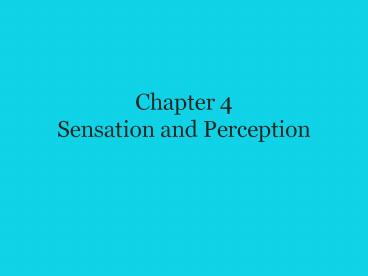Chapter 4 Sensation and Perception PowerPoint PPT Presentation
1 / 33
Title: Chapter 4 Sensation and Perception
1
Chapter 4Sensation and Perception
2
The Man Who Mistook His Wife for a Hat
- By neurologist Oliver Sacks describing his most
fascinating patients - The case of Dr.P is most interesting for
neuropsychology and the study of the effect of
brain damage on behavior.. Dr.Ps condition would
cause him to commit strange Mr. Magoo-like
mistakes from which we may draw inferences about
his rare disorder. - For example he would often mistake inanimate
objects for people, and he had a problem
recognizing people by face. - Dr.P appeared to have lead a normal, good natured
and full life with profound musical talent.
3
Dr. P
- Unable to recognize a rose by sight, Dr. P could
identify it by smell. - He described it as
- About six inches in length, a convoluted red
form with a green linear attachment
4
Sensation and Perception The Distinction
- Sensation stimulation of sense organs
- Perception selection, organization, and
interpretation of sensory input - Psychophysics the study of how physical stimuli
are translated into psychological experience
5
Figure 4.1 The distinction between sensation and
perception
6
Psychophysics Basic Concepts
- Sensation begins with a detectable stimulus
- Fechner the concept of the threshold
- Absolute threshold detected 50 of the time
- Just noticeable difference (JND) smallest
difference detectable - Webers law size of JND proportional to size of
initial stimulus (1/3 of original stimulus)
7
(No Transcript)
8
Psychophysics Concepts and Issues
- Selective Attention
- Cocktail party effect type of selective
attention in which you can attend to only one
voice at a time - Cell phones and driving? Listening to music and
studying? - Card Trick
- Who Dunnit?
9
Psychophysics Concepts and Issues
- Signal-Detection Theory Sensory processes
decision processes - Depends on the criteion you set for how sure you
must feel before you react - Depends on noise in the background
- Listening for a doorbell at a party
10
Figure 4.3 Signal-detection theory
11
Psychophysics Concepts and Issues
- Subliminal Perception Existence vs. practical
effects - Sublimnal means below threshold
- 1957 Eat Popcorn messages in movies increased
popcorn sales - Jon Krosnick (1992) hidden messages to affect
feeling about neutral situations significant
difference. - Disney Movies
- Lyrics in Reverse
12
Psychophysics Concepts and Issues
- Sensory Adaptation Decline in sensitivity to a
stimulus over time - Jumping into a cold pool
- Stinky garbage in the kitchen
- Why would we adapt to sensations?
13
Sensory Transduction
- In physiology, transduction is the conversion of
a stimulus from one form to another. - Transduction in the nervous system typically
refers to stimulus alerting events wherein a
mechanical/physical/etc stimulus is converted
into an action potential which is transmitted
along axons towards the central nervous system
where it is integrated - The process of converting a sensation into a
perception
14
The EyeConverting Light into Neural Impulses
- The eye housing and channeling
- Components
- Cornea where light enters the eye
- Lens focuses the light rays on the retina
- Iris colored ring of muscle, constricts or
dilates via amount of light - Pupil regulates amount of light
Iris, Cornea, and Lens
15
Figure 4.7 The human eye
16
The Retina An Extension of the CNS
- Retina absorbs light, processes images
- Optic disk optic nerve connection/blind spot
- Receptor cells
- Rods black and white/low light vision
- Cones color and daylight vision
- Adaptation becoming more or less sensitive to
light as needed
Retina, Optic Nerve, Brain
17
Figure 4.8 Nearsightedness and farsightedness
18
Figure 4.9 The retina
19
Figure 4.10 The process of dark adaptation
20
Visual Information Processing
- Light ? rods and cones ? neural signals ? optic
nerve ? optic chiasm ? lateral geniculate nucleus
(thalamus) ? opposite half brain ? primary visual
cortex (occipital lobe)
21
Figure 4.13 Visual pathways through the brain
22
Figure 4.15 The what and where pathways from the
primary visual cortex
23
Hubel and WieselFeature Detectors and the Nobel
Prize
- Early 1960s Hubel and Wiesel
- Microelectrode recording of axons in primary
visual cortex of animals - Discovered feature detectors neurons that
respond selectively to lines, edges, etc. - Groundbreaking research Nobel Prize in 1981
- Later research cells specific to faces in the
temporal lobes of monkeys and humans
24
Theories of Color Vision
- Trichromatic theory - Young and Helmholtz
- Receptors for red, green, blue color mixing
(like old televisions) - Colorblind dichromatic
- Opponent Process theory Hering
- 3 pairs of antagonistic colors
- red/green, blue/yellow, black/white
- Current perspective both theories necessary
25
Figure 4.18 The color circle and complementary
colors
26
The Afterimage Effect
- A visual image the persists after a stimulus is
removed - Will be a compliment color to original stimulus
- Castle Afterimage Effect
27
Perceiving Forms, Patterns, and Objects
- Bottom-up processing
- Elements to the whole
- Top-down processing
- Whole to elements
- Top dwon prcossenig alolws
- you to raed snetneces like this.
28
Bottom-up v. Top-down
29
Stroop Effect
30
Reversible figures
31
Reversible Image
32
Reversible Image The Necker Cube
33
Figure and Ground
- First step in perceiving an image is determining
figure and ground.

